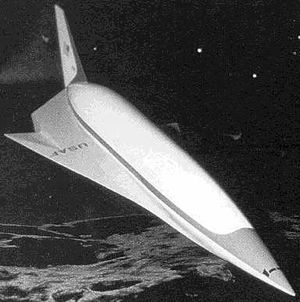
Home - Search - Browse - Alphabetic Index: 0- 1- 2- 3- 4- 5- 6- 7- 8- 9
A- B- C- D- E- F- G- H- I- J- K- L- M- N- O- P- Q- R- S- T- U- V- W- X- Y- Z
X-30
 X-30 TAV Credit: NASA |
AKA: Copper Canyon Phase 2;HySTP;NASP (National Aerospace Plane);National Aerospace Plane;Orient Express. Status: Cancelled 1990. Thrust: 1,370.00 kN (307,980 lbf). Gross mass: 140,000 kg (300,000 lb). Unfuelled mass: 60,000 kg (132,000 lb). Specific impulse: 1,550 s. Specific impulse sea level: 1,550 s. Burn time: 886 s. Height: 96.00 m (314.00 ft). Diameter: 16.00 m (52.00 ft). Span: 36.00 m (118.00 ft).
The X-30 National Aerospace Plane (NASP) was the public follow-on to the classified Defense Advanced Research Projects Agency (DARPA) Copper Canyon program of 1982-1985. President Reagan announced the project in his 1986 State of the Union message, calling for development of "...a new Orient Express that could, by the end of the next decade, take off from Dulles Airport and accelerate up to twenty-five times the speed of sound, attaining low earth orbit or flying to Tokyo within two hours...".
This program to develop an single-stage-to-orbit, horizontal takeoff/horizontal landing, air-breathing scramjet manned vehicle started at Phase 2 (Copper Canyon was Phase 1). In this phase the essential new materials, structures, and manufacturing processes would be validated. These included a composite hydrogen tank, a propellant utilization fraction of 0.74, carbon-carbon aerodynamic surfaces, high temperature heat pipe sharp leading edges, use of computational flow dynamics to model the scramjet and aerodynamic shape, and slush hydrogen as a fuel. Phase 3, the actual design, construction and flight testing of the aircraft, was to begin in 1990.
The Department of Defense was to fund $2.65 of the $3.33 billion Phase 2 development cost over eight years. It was never made quite clear what the Defense Department's interest in the project was. Many observers believed that it was all an elaborate cover for development of one or more heavily-classified high-technology vehicles.
Prior to Copper Canyon it had been believed that scramjets could not power a vehicle beyond Mach 9. The NASP concept involved circulating and heating the hydrogen fuel through the skin of the vehicle prior to injection into the engine. In this manner the energy generated by atmospheric drag was essentially added to the thrust of the scramjet. It was believed the correct active thermal management approach would allow NASP to reach the orbital speed of Mach 25 without the use of heavy supplemental rocket engines.
As Phase 2 progressed, it became apparent that the Mach 25 goal was not achievable. Mach 20 seemed to be the maximum attainable, and practical considerations of limiting the mass of the active thermal management system further limited the top speed to Mach 17. A rocket engine would still be needed to take the vehicle into orbit.
Meanwhile the original cost project cost had tripled to $10 billion. Completion of Phase 3 flight test would have added another $7 billion with first flight not until 2001. Another decade and $10 to $20 billion would be needed to fully develop an operational vehicle suitable for commercial and military use. The cost overruns and the collapse of the Soviet Union removed any support that may have once existed for such a costly long-term development program. The NASP never died on a particular date but rather sort of petered out. A Hypersonic Systems Technology Program (HySTP) was initiated to continue joint NASA/USAF cataloguing of the billions of dollars worth of technology developed for NASP. On 27 January 1995 the Air Force ended participation in HySTP, ending the last gasp of NASP.
To this day it is not clear whether NASP, like Reagan's 'Star Wars' SDIO, was a genuinely intended program, a huge deception operation to force the Soviet Union into development of costly equivalents, or a cover for other classified projects. Probably it was a bit of all three, and different things to different participants. In any case it was, like SDIO, a case of sever technical over-reach.
Development Cost $: 3,000.000 million in 1985 dollars.
Stage Data - X-30
- Stage 1. 1 x X-30. Gross Mass: 140,000 kg (300,000 lb). Empty Mass: 60,000 kg (132,000 lb). Thrust (vac): 1,370.000 kN (307,980 lbf). Isp: 1,550 sec. Burn time: 886 sec. Isp(sl): 1,550 sec. Diameter: 16.00 m (52.00 ft). Span: 36.00 m (118.00 ft). Length: 80.00 m (262.00 ft). Propellants: Air/Slush LH2. No Engines: 1. Engine: Scramjet. Other designations: NASP (National Aerospace Plane); Orient Express. Status: Development 1990.
| Copper Canyon American winged orbital launch vehicle. DARPA program of 1984 that proved the technologies and concept for the X-30 National Aerospace Plane concept. |
Family: orbital launch vehicle, Space station orbit, Spaceplane, SSTO, US Rocketplanes, Winged. Country: USA. Engines: Scramjet. Agency: USAF. Bibliography: 281, 48.
 | X-30 Concept Credit: NASA |
Back to top of page
Home - Search - Browse - Alphabetic Index: 0- 1- 2- 3- 4- 5- 6- 7- 8- 9
A- B- C- D- E- F- G- H- I- J- K- L- M- N- O- P- Q- R- S- T- U- V- W- X- Y- Z
© 1997-2019 Mark Wade - Contact
© / Conditions for Use